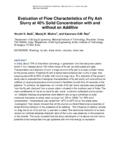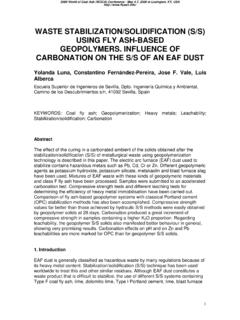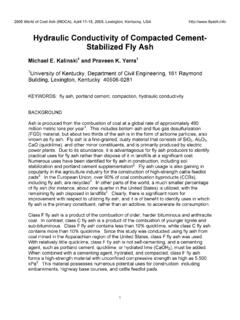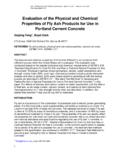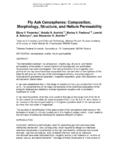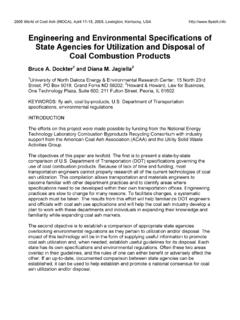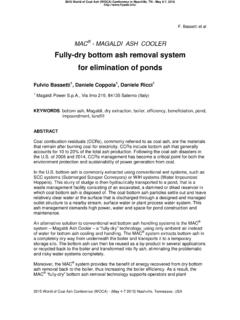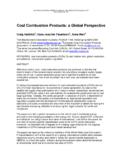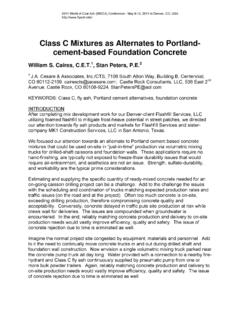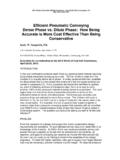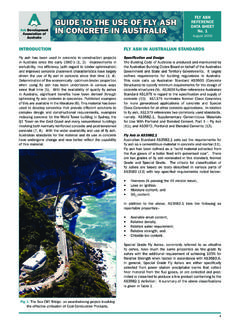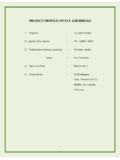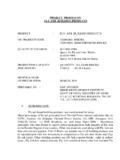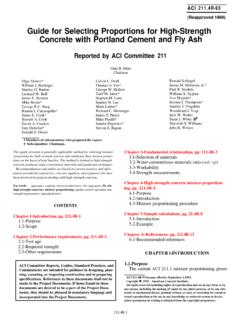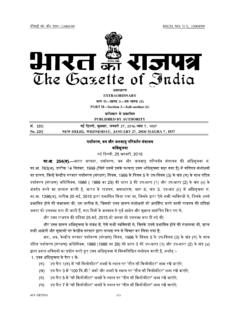Transcription of Fly Ash Classification Old and New Ideas
1 fly ash Classification Old and New Ideas John M. Fox1 1 BASF Corporation, 23700 Chagrin Blvd., Cleveland, OH 44122 CONFERENCE: 2017 World of Coal Ash ( ) KEYWORDS: fly ash , composition, Classification fly ash Classification A key component of North American fly ash Classification has long been major element chemistry by weight percentage: SiO2 + Al2O3 + Fe2O3 in the ; CaO in Canada. The Canadian Standards Association (CSA) and the American Society for Testing and Materials (ASTM) recognize two classes of fly ash : Class F, normally produced from high-rank coals, and Class C, normally produced from low-rank coals. Coal rank has traditionally been an aspect of fly ash Classification , particularly the division between low and high rank. In the search for an improved Classification that provides meaningful information about the use of fly ash in concrete, the current classifications and the validity of using coal rank in Classification are questioned.
2 The transition from the current ASTM C 618 specification in the to a fly ash Classification based on CaO (lime), is a necessary and logical step if a more useful Classification is to be adopted. Iron oxide is essentially a nonreactive component of fly ash and is not expected to be correlated to fly ash performance in ,2 The SiO2 Al2O3 CaO (SAC) ternary diagram accurately predicts fly ash phase mineralogy and is a very useful tool for understanding geochemical variations between fly ashes from differing coal ranks and geological settings. fly ash quality measures have been established based on major element chemistry. Recent studies have shown that the network ratio of fly ash glass is a rigorous indicator of fly ash performance in concrete. A simple geochemical variation diagram provides a measure of fly ash alkalinity that correlates relatively closely with the network ratio.
3 fly ash Classification based on weight percent CaO is a far better approach than the traditional ASTM C 618 standard. The Canadian Standards Association (CSA) specification of low-, intermediate-, and high-CaO fly ashes may be a better approach to fly ash Classification than the more simplified concept of splitting fly ashes into Class F and Class C at 18% CaO. 2017 World of Coal Ash (WOCA) Conference in Lexington, KY - May 9-11, 2017 RANK Coal rank, as defined by ASTM D 388, is a concept rather than a property and is not measured but is assessed by physical and chemical properties which change during the process of Rank is the degree of transformation from vegetation to coal. Coalification increases with rank in the sequence peat lignite subbituminous bituminous - semi-anthracite anthracite meta-anthracite.
4 High rank coals include bituminous and anthracite. Lignite, also termed brown coal, and subbituminous coals are the low rank coals. During an initial biochemical phase diagenetic changes occur in the peat swamp until bacterial activity ceases at burial depths of greater than 10 meters and the hard brown coal stage is reached. Further increasing rank is the onset of the geochemical or metamorphic stage of coalification, leading to significant changes in organic material and volatiles as carbon content increases and hydrogen and oxygen Coalification is a highly complex chemical process. Metal elements such as Ca, Mg, Fe, and K originating primarily from coal swamp plant matter, with less input from pore solutions originating from rock alteration and weathering, are primarily bound in the form of humates.
5 Humic acids, as well as functional, carboxyl, and carbonyl groups, decrease with increasing coal rank. When high rank is reached, bituminous and anthracite coals contain essentially no carboxyl and carbonyl groups and humic acid complexes are Before conversion to bituminous coal, the low rank coals contain metal-organic compounds such as polymerized humic substances and macromolecules of essentially aromatic and aliphatic habit. Much of the alkali and alkaline earth metal content of lignites is held organically as chelated complexes. Water in the low rank coal acts as a solvent, transmitter and donner of elements. Each coal basin has a different geochemistry that determines the amount of Ca, Na, Mg, and K held in the organic molecules and pore , 6 As coal rank transitions from subbituminous to bituminous coal a natural boundary is crossed between low rank brown coal and high rank hard or black coal which is accompanied by a significant increase in vitrinite reflectance.
6 The conversion of subbituminous to bituminous coal marks a disappearance of humic acid and a significant loss of moisture, organic and volatile compounds, and alkali metals that were in solution and tied up in organic molecules. Expressed fluids and gasses take with them the alkali and alkaline earth metals that are typically more abundant in the low rank coals, leaving high rank coal with a characteristically low content of Ca, Na, and Mg and a characteristically high vitrinite ,7,8 It is remarkable how variable alkali and lime contents are between low rank coal basins. Although some chemical variations stem from differing coal types; humic or woody coals and sapropelic or non-woody coals9, the geology and geochemistry is of prime importance. Variations in the geochemistry and geological setting of coal basins can be visualized on the SAC ternary diagram and with a traditional alkalis-silica variation diagram.
7 Coal rank is a key in understanding coal and how to meaningfully classify fly ash . fly ash QUALITY MEASURES fly ash quality measures have been established based on major element chemistry and The cementing efficiency of fly ash in concrete has been shown to be related to the physical and chemical properties of the fly ash . fly ash cementing efficiency factors have been defined on the basis of cement replacement level, concrete strength, and water to cementitious materials ratio; however, based solely on these constraints the overall cementing efficiency of fly ash is not adequately Comprehensive measures of fly ash quality in terms of pozzolanic reactivity commonly include compressive strength testing of mortar cubes in conjunction with chemical Recent in-depth studies have shown that the network ratio of fly ash glass is a rigorous indicator of fly ash performance in concrete.
8 Detailed studies of seven typical fly ashes representing typical North American sources have shown a strong correlation between glass transition temperature and the amorphous X-ray diffraction (XRD) peak position. Using a combination of major element composition, XRD, and Scanning electron microscopy (SEM) a parameter of ash performance in cementitious systems has been developed that is termed the network ratio (Nr). fly ash glass compositions that yield a high Nr value contain a higher lime content and are more reactive in Although a powerful tool for understanding fly ash reactivity potential, determination of Nr values requires access to XRD and SEM and the calculation is somewhat detailed. Geochemical indicies of fly ash that are correlated to the Nr value may be useful. ALKALI INDICIES A fundamental geochemical tool in petrology is the Harker diagram with weight percent alkalis on the ordinate.
9 Although primarily used as a measure of alkalis in igneous rocks, this simple variation diagram is more widely useful. The Harker diagram of weight percent silica plotted against weight percent alkalis from LeMaitre, showing over 25,000 igneous rock analyses, can be used to visualize the main sequence of (Figure 1) End points of weight percent SiO2 values having the greatest frequency define a linear codabular function across the Daly gap that they frame. Departure of weight percent alkali values from the codabular function Y = X gives the most general expression for alkalinity as codabular variation (cv). Figure 1. Harker diagram generalized from LeMaitre, 1976. Black points define endpoints of the codabular function. (Courtesy of Elizabeth Fox) Plotting the fly ash compositional data of Oey, et.
10 Al., 201513 in terms of Nr and cv shows a relatively close correspondence. (Figure 2) Figure 2. A plot of Nr vs. cv values shows they vary directly and are well correlated. Building upon the work of Shand,15 an aluminum saturation index (ASI) has been used to classify fly ashes. The ASI is Al2O3/(CaO + K2O + Na2O) on a molar The relationship between the Nr values and the ASI of Zen, 1986 for the fly ashes studied by Oey, et. al., 2015 is shown in Figure 3. Figure 3. A plot of Nr vs. ASI values shows they are approximately correlated. A modified ASI index given by Al/(Na + K + 2Ca) has also been used to characterize fly ash The relationship between the Nr values and the ASI of Sisson, et. al., 2005 for the fly ashes studied by Oey, et. al., 2015 is shown in Figure 4. Figure 4. A plot of Nr vs.
